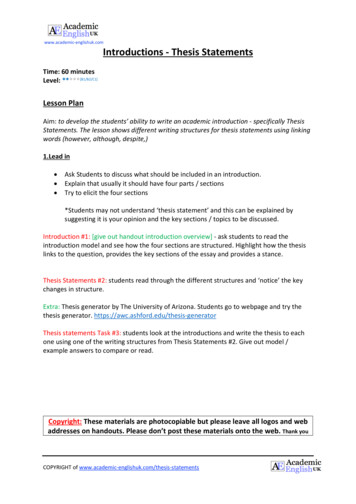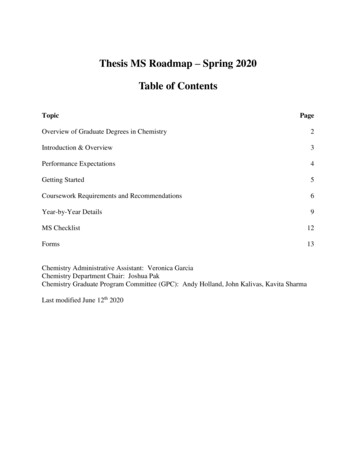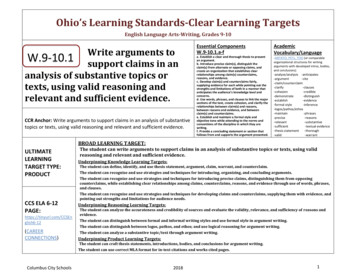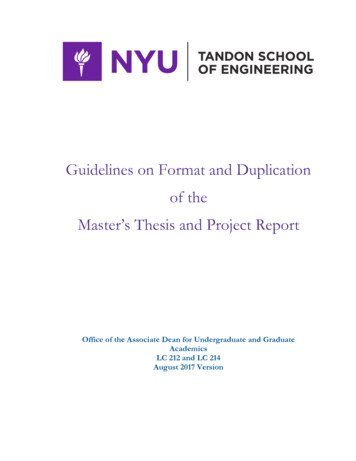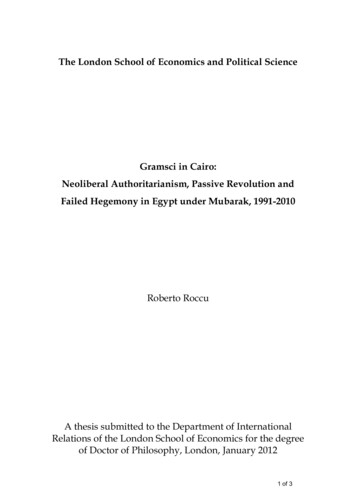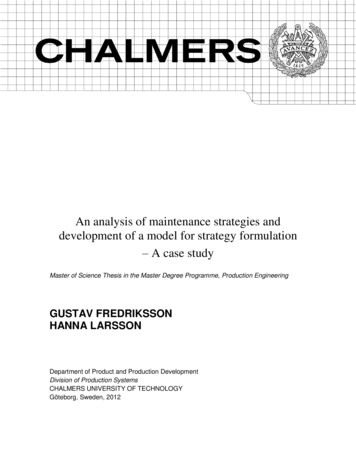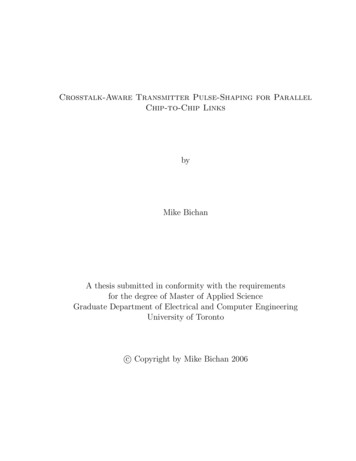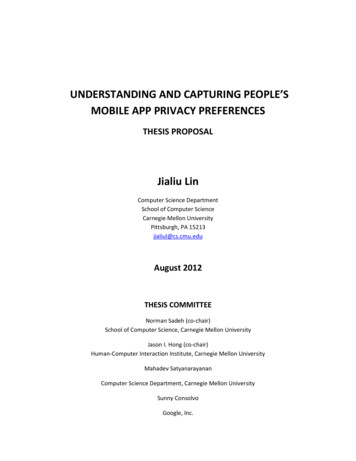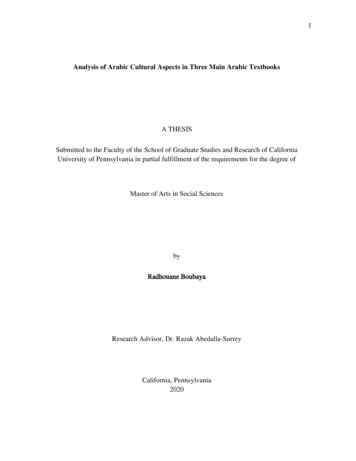
Transcription
1Analysis of Arabic Cultural Aspects in Three Main Arabic TextbooksA THESISSubmitted to the Faculty of the School of Graduate Studies and Research of CaliforniaUniversity of Pennsylvania in partial fulfillment of the requirements for the degree ofMaster of Arts in Social SciencesbyRadhouane BoubayaResearch Advisor, Dr. Razak Abedalla-SurreyCalifornia, Pennsylvania2020
10/6/202010/6/202010/6/2020
3AcknowledgmentsI want to thank my supervisor Dr. Razak Abedalla-Surrey for his valuable guidance and themembers of my thesis committee, Dr. Arcides Gonzalez and Dr. Abdullah Alsaffar, for theirsuggestions and recommendations.My sincere gratitude goes to my wife Abir, my son Ayoub and my daughter Samar for theirinvaluable support and patience especially during the Corona-virus pandemic.
4AbstractThere is no doubt that culture represents a vital component in the foreign language curriculum.Over the past decades, foreign language textbooks, as a key element in the teaching and learningprocess, covered culture differently qualitatively and quantitatively and the Arabic textbooks areno exception. This study aims to evaluate the presence of Arab culture in three main Arabictextbooks widely used in western institutions. The researcher applied a content analysismethodology to extract and examine the cultural aspects incorporated into these textbooks. Thefindings show a strong emphasis on the geographical, religious, and literary aspects and lessfocus on the societal and economic aspects and those related to the Arabs’ daily lifestyle andleisure. The results could be used to decide which textbooks are more suitable for a specificcurriculum and to help improve future educational material’s content.Keywords: Arabic Language, Arab Culture, Arabic Textbook, Cultural Competence,Content Analysis Intercultural Communication, Cultural Aspects, Cultural Content,Alif Baa, Al-Kitaab, Ahlan wa Sahlan, Arabiyyat-al-Naas.
5Table of contentsStatement of the Problem12Purpose of the Research13Research Questions13Significance of the Study13Limitations and Delimitations14LITERATURE REVIEW15Importance of the Culture15Integrating Culture in the Foreign Language Curriculum18RESEARCH METHODOLOGY21Research Design21Advantages of Content Analysis22Disadvantages of Content Analysis22Steps of Content Analysis24Data Analysis25Criteria Applied26Alif Baa27Al-Kitaab - Part One29Al-Kitaab - Part Two31Ahlan wa Sahlan – Part One33Ahlan wa Sahlan – Part Two34Arabiyyat-al-Naas – Part One37Arabiyyat-al-Naas – Part two39Arabiyyat-al-Naas – Part Three41RESEARCH FINDINGS43SUGGESTIONS & CONCLUSION46Suggestions46Conclusion48
6List of TablesTable 1: List of the textbooks subjects of this study23Table 2: Frequency of cultural elements in Alif Baa27Table 3: Frequency of cultural elements in Al-Kitaab - Part One29Table 4: Frequency of cultural elements in Al-Kitaab - Part Two31Table 5: Frequency of cultural elements in Ahlan wa Sahlan - Part One33Table 6: Frequency of cultural elements in Ahlan wa Sahlan - Part Two35Table 7: Frequency of cultural elements in Arabiyyat-al-Naas-Part One37Table 8: Frequency of cultural elements in Arabiyyat-al-Naas-Part Two39Table 9: Frequency of cultural elements in Arabiyyat-al-Naas-Part Three41Table 10: Frequency of cultural elements in all textbooks43
7List of FiguresFigure 1: Part of each cultural element in Alif Baa28Figure 2: Part of each cultural element in Al-Kitaab - Part One30Figure 3: Part of each cultural element in Al-Kitaab - Part Two32Figure 4: Part of each cultural element in Ahlan wa Sahlan - Part One34Figure 5: Part of each cultural element in Ahlan wa Sahlan - Part Two36Figure 6: Part of each cultural element in Arabiyyat-al-Naas-Part One38Figure 7: Part of each cultural element in Arabiyyat-al-Naas-Part Two40Figure 8: Part of each cultural element in Arabiyyat-al-Naas-Part Three42
8Every nation has its own culture that is distinguished from others, and that culture isreflected in the language of its people. Language and culture are reciprocally connected andboth acquired socially. This undeniable interconnection is evident in the field of foreignlanguage teaching in general, and Arabic language education in particular. Teaching culturewithout language does not benefit learners. Likewise, teaching language without its culturalcontent is teaching meaningless symbols and formative templates.Culture in the broad meaning consists of two main components: on one hand, it is theanthropological or social culture, which includes customs, attitudes, and traditions, and on theother hand, it is the history of civilization, which contains arts, scientific achievements, andsocial sciences. The second component is based on the first element, as it presents the heritageof the society, and therefore must be known to learners to understand the target culture.Also, the combination of language and culture leads to the development of linguistic andcultural skills among learners, makes them better responsive to native speakers and thereforeunderstand their ideas and behaviors. We can perceive the importance of this interrelationshipwhile noticing that foreign language learners not only broaden their horizons for the targetedculture but also rediscover their own culture to the point that they look at it differently thanbefore. Consequently, learners become more respectful toward other cultures and moreappreciative of the feelings of others as they can grasp their cultural implications.Brown (2007), Schultz (2007), and Tang (1999) have demonstrated that teaching alanguage along with culture and without an intermediate language is very effective. Otherwise,the teaching process becomes a waste of time and effort for both the educator and the learnerbesides the language becoming useless and difficult to understand. Hence, culture has a greatimpact on learners, as it causes to develop a positive attitude towards the language they are
9learning especially if the teaching process is enjoyable and interesting as learners discover newcultural patterns different from their own which leads to increasing their interests andstimulating their motivation to learn about cultural habits and customs.Acquiring knowledge and learning new skills to succeed professionally and personallyhave been always the main goal of receiving an education. That is why the teachers’ role is vitalas they continually “engage the student and find what makes the student interested in thesubject” (Slapik, 2017, para. 9). Their role becomes more challenging while teaching foreignlanguages which is one of the social science’s major subjects. Social science is the study ofhuman society and social relationships where students learn a range of sciences such asanthropology, archaeology, economics, geography, history, and law. Teaching and learningforeign languages have constantly been the subject of several studies and researches in the 20thcentury and the first two decades of the 21st century.While there are several reasons behind learning a new language, from being able tospeak to more people (Duffin, 2020), to boosting cross-cultural understanding (Boroditsky,2010), to improving test scores in core subjects (the American Council on the Teaching ofForeign Languages, n.d.), the process of learning a foreign language allows learners to discoverother civilizations and gives them a unique opportunity to exchange experiences and knowledgewith others; thus, cultural awareness empowers learners to build relationships with people fromvarious regions of the world, as well as to respect their values, races, and backgrounds.Also, by being able to understand foreign cultures, learners can watch foreign movies,listen to foreign music, discover foreign literature in the native speakers’ language, and uncoverthe history of other countries. At a certain point, language learners reconsider their own culture
10and understand it in a new way as they draw new perspectives while discovering the benefit ofbeing emancipated from monolingualism.On the personal level, learning a foreign language will make traveling much easier asmastering the local language enables learners to read local newspapers and easily order localfood, besides finding more loving and welcoming native speakers as a result of speaking theirlanguage, showing interest and understanding of their history and culture (Gorsky, 2019).On the professional level, several studies show that acquiring a new language willbenefit businesses (Jolin, 2014) by improving analytical skills, along with work skills, creativityand problem solving, and promotes opportunities to participate in the business, medicine, law,trade, technology, industry, and marketing.Undeniably, learning a new language implies discovering a whole new culture: the truemeaning of a language is within the culture conveyed not its vocabulary, grammar or syntax.Hence, learners are expected to not only use the language to communicate and interact withnative speakers but employ the language’s cultural trait and excel in various real-lifeexperiences. To this end, educators should assist language learners in acquiring every skillneeded to achieve language and cultural proficiency.The World-Readiness Standards for Learning Languages identify culture as the “truecontent of the foreign language course” and as one of the standards’ goal areas or also one ofthe five Cs in learning a foreign language (Clementi & Terrill, 2017). While teaching a foreignlanguage, the cultural part is sometimes overlooked and even disregarded especially at thebeginner and intermediate level or when barriers exist such as beliefs and attitudes (Yang &Chen, 2016). This could happen when teachers only rely on outdated and/or non-authentic
11material which may omit crucial cultural elements that are part of the language being taught.Furthermore, language learners often focus on the communicative facet of the language andignore the fact that a word or a sentence might have more than one meaning which variesaccording to the context.Textbooks, as the most widely used educational materials, still represent a valuableresource that supports learners in developing their foreign language proficiency. They are anessential tool used by educational institutions to ensure a successful teaching and learningexperience. In a typical foreign language classroom, most educators tend to focus on teachingsyntax, phonology and other communication skills to improve their learners’ reading, listening,writing and speaking skills in the target language.Occasionally, they are unaware that grasping those skills is insufficient for learners to becapable of reflecting on several issues and concepts appropriately once they are in a culturallydifferent context. That is why it is crucial to incorporate cultural content as much as possible inevery single step of the foreign language course curriculum.This study intends to investigate, assess and compare the cultural content in three mainArabic textbooks used by English-speaking learners and determine the extent of culturalelements incorporated into these textbooks to develop a conception of how culture isrepresented in each textbook. The results should provide the readers with a clear picture of howeach textbook and series of textbooks integrated Arab culture and the type of cultures that ismost and least represented on each one.
12Statement of the ProblemGiven the importance of the culture's role in enhancing language learning, andnotwithstanding the emergence of several technology tools, such as websites and applications,as part of learning, textbooks are still considered a vital part of the teaching and learningprocesses for both educators and learners.Moreover, as indicated in the StarTalk endorsed principles for effective teaching andlearning, an idealistic learning curriculum incorporates culture, content, and language wherelearners benefit from age-appropriate authentic materials and engage in “meaningful, real-worldlearning experiences that prepare them to use the target language beyond the classroom"(STARTALK Principles for Effective Teaching & Learning, 2020, para 1).Despite classifying Arabic by the U.S. Foreign Service Institute (2019) as a "super-hardlanguage" along with Chinese Cantonese, Chinese–Mandarin, Japanese and Korean (ForeignLanguage Training, n.d.), educators and learners have been encouraged to not focus only on thecommunicative part of the language, but also take the Arab culture and civilization inconsideration and incorporate it as much as they can in the course curriculum.Culture represents the pillar of the language itself. Thus, language educators shouldmake every effort to include all cultural aspects in every step of their curriculum. Despite therise of technology, textbooks are still indispensable for foreign language learners since theyinclude a wealth of reliable resources and references that help them achieve higher proficiency.Through these same textbooks, educators try to convey the appropriate cultural content to theirlearners hoping to supply them with the necessary tools that enable them to become culturallyaware and ready to interact in cross-cultural situations.
13Purpose of the ResearchThe purpose of this study is to analyze selected Arabic textbooks, extract their Arabiccultural content and make comparisons and inferences about the amount and type of culturalelements that have been incorporated in each one of them.Research QuestionsThe following are the questions this study attempted to answer: Does every textbook reflect a variety of Arabic cultural aspects? Does the cultural content differ from a textbook to another? If so, to what extent? Is there enough cultural content on each textbook for Arabic learners to reach aminimum of cultural competence? In other words, how well these textbooksprepare Arabic learners to achieve cultural proficiency?Significance of the StudyThis study is an effort to help Arabic language educators, as well as educationalinstitutions, make an informed decision about the most suitable academic materials for Arabiclearners regarding the Arabic cultural content richness and diversity. The study’s findings aremeant to create some sort of reference for Arabic language teachers along for learners fromdifferent levels and backgrounds who are discovering the Arab culture and intending to becomemore familiar with the native speakers’ customs and traditions in their journey of learningArabic. Therefore, learners should be able to select the textbooks that match their proficiencylevel while, at the same time, they consider their motivation and aspirations behind learning aforeign language such as Arabic.
14The results of the study could be relevant to potential researchers as these results maybecome useful to improve future curriculum and supplement the teaching process withadditional materials. This research was conducted mainly to: Investigate, analyze and compare the cultural content incorporated in variousArabic textbooks used in western universities. Assess and interpret the cultural information being taught on these textbooks.Limitations and DelimitationsWhile the researcher made every effort to include all relevant data into the study, itworth mentioning the following points: The textbooks included textual and visual contents about various Arabic culturalaspects in a contextual setting in English and Arabic: the researcher extractedonly unambiguous data related to different cultural categories in both StandardModern Arabic and local dialect. Cultural content in the source language: the researcher took into considerationthe cultural data presented in Arabic only. There are instances where thetextbooks explained Arab culture in English; these instances were not included. Cultural elements related to the communicative part of the language such as theArabic Alphabet were not counted as a cultural element in this research as it ispresented to be learned mainly as a linguistic tool. Analyzed cultural content: for the simplicity and brevity of the study, theresearcher intentionally omitted the online content as it is more frequentlyupdated compared to the physical textbooks.
15Literature ReviewImportance of the CultureThe relation between language and culture has been always the subject of severalstudies. Researches findings demonstrated that mastering a language does not only implygrasping its vocabulary and grammar, it also entails assimilating all aspects related to thatlanguage most importantly the cultural aspect. “To speak a language is to take on a world, aculture.” (Fanon, 1967, p.25).Arabic, as one of the fastest-growing languages in the U.S. with an increase of 42percent from 2010 to 2017 (Zeigler & Camarota, 2018), is considered a language with asignificant cultural richness. Merriam-Webster (n.d.) defines culture as “the customary beliefs,social forms, and material traits of a racial, religious, or social group." It also describes it as the"characteristic features of everyday existence (such as diversions, or a way of life) shared bypeople in a place or time.'' Since the language is not seen as a way of communication solely,culture became a vital component of language learning.In effect, culture is one of the five goal areas outlined in the world-readiness standardsfor learning languages published by the American Council on the Teaching of ForeignLanguages (ACTFL). Byram and Esarte-Sarries (1991) emphasized the significance ofincorporating culture as a part of the language learning curriculum. What corroborates therelation between learning a language and acquiring the secrets of its culture is that learners find
16themselves facing a new world, different from their own and wonder about their ability to applythis new language in real life. That is when they decide to either accept it and continue theirjourney in acquiring more vocabulary and knowledge or reject it and refuse to dig more into itsculture and literature.This is so true in the case of the Arabic language since learners assess their ability tomaster Arabic while confronting native speakers in the real-life setting and using their speaking,writing and reading skills, and most importantly, their cultural awareness and discovering thedifferences between their own culture and the one being studied. Failure to identify thosedifferences might put them in an ironic position or become a subject of misinterpretation anddisagreement.While learners may have diverse reasons behind learning a foreign language, there arethree main goals they are seeking to accomplish which are: Language proficiency: Robinson (2013) define language proficiency as “a measurementof how well an individual has mastered a language. It is often measured in terms ofreceptive and expressive language skills, syntax, vocabulary, semantics and other areasthat demonstrate language abilities” Communicative competence: learners can use the language accurately, appropriately andflexibly. According to Hymes (1972), it refers to the use of language in situationally andsocially appropriate ways. Canale and Swain (1980) defined communicative competenceas the learner's ability to use the language to engage in an exchange of information orideas effectively in four areas: words and rules, appropriacy, cohesion and coherence,and use of communication strategies.
17 Intercultural Communication: defined by ACTFL and the National Council of StateSupervisors for Languages (NCSSFL) as “a complex activity that combines crosscultural knowledge and language skills. It involves initiating, understanding andresponding to what is communicated, using culturally appropriate language and behaviorin a given context”.Without culture, learners cannot assimilate the meanings behind the words being said orwritten in the foreign language and without language, they cannot uncover its cultural attributes.The main question that all educators and scholars involved in teaching culture in the Arabiclanguage classroom may ask is: which culture should we convey and emphasize to our learnersand which one is considered most useful and pertinent to their background and expectations?While teaching Arabic to non-Arabic speakers, educators should consider four majorcultural categories to incorporate in their curriculum: Local culture: the one that distinguishes each Arab country or region within a countryfrom another. It could be related to the specific local customs and rituals such asgreetings and weddings, or a particular place or event such as a monument or a nationalholiday. Islamic culture: religious aspects originated from Islam that refers to cultural practicescommon to Muslims. Arabic culture: all the cultural characteristics found originally in the Arab world andshared across all Arab countries. Universal culture: culture shared everywhere all over the world regardless of localcustoms and traditions such as respect and kindness.
18Integrating Culture in the Foreign Language CurriculumThe intertwined relationship between culture and language is undeniable. Culture is,without a doubt, a crucial element in teaching a foreign language. Recent studies and researchfindings confirm that learners are incapable to achieve a high level of successful languagecommunication proficiency without comprehending its cultural context. The latestmethodologies in teaching foreign language suggest that lessons, discussions, stories, andwritings cannot be separated from their diverse cultural backgrounds.For a language learner, being proficient in speaking, listening, reading and writing usedto be the exclusive goal of teaching a foreign language; not anymore! Today, this can be doneusing a wealth of tools, besides the “classic” textbooks, such as mobile applications, specializedwebsites, and online instructional videos. The challenge of the 21st century, within a globaleconomy, is to be culturally aware of the differences, beliefs, views, and prejudices whilepursuing and take part in meaningful interactions with people and organizations of diversebackgrounds around the globe.This idea emphasized the integration of culture in the textbooks as a pillar of languageteaching. As Bateman and Mattos (2006) mentioned, a wave of efforts to incorporate culturalelements into some textbooks started between the 1930s and the 1960s by “incorporatingphotographs and narratives about aspects of daily life in the target cultures” in Spanish andPortuguese. Since then, textbooks targeting language learners became more and more inclusiveof authentic materials portraying pictures of native speakers, real conversations and storiesoriginated from the target culture.The interest in the cultural characteristic incorporated in the teaching textbooks targetingforeign language learners keeps growing in recent years and language proficiency became
19contingent on cultural proficiency. Brooks (1968) recommended that since teaching culture isessential in the language curriculum, culture should be interpreted at two different levels:“scientific and humanistic” suggesting considering a framework for each level.In 1975, Brooks highlighted the need for centering foreign language teaching onlearners’ desires and making foreign culture more acceptable and reassuring to the languagelearner. This era followed the rise of the audiolingual method in teaching foreign languages,which emphasizes learning to listen and speak before reading and writing. It is when thememorization of short sentences through repetition was introduced to help learners acquiresome of the cultural aspects of the target language.At the beginning of the 21st century, we witnessed a significant increase in the studiesand researches attempting to further investigate the importance of incorporating more culturalelements in the foreign language curriculum and trying to uncover the best practices to achievecommunicative and cultural proficiency. In their analysis of the cultural content in English as aforeign language (EFL) textbooks in Colombia, Rodriguez and Fernando (2015) discovered thatthese textbooks contain mainly information representing the surface culture and almostcompletely ignore deep culture.Cutshall (2012) stressed that the most valuable content taught in the foreign languageclassroom is the culture communicated through that language, not its vocabulary nor grammar.Cutshall described culture as a framework in the form of a triangle comprised of threecomponents: perspectives, products, and practices, or the “3Ps”. The perspectives represent themeanings, attitudes, values, and ideas. The products include the tangible and intangible parts ofthe culture such as books, food, and dress. The practices are the patterns of social interactions orbehaviors such as rites of passage and use of space.
20In her thesis submitted to the faculty of Brigham Young University, Asay (2016)investigated the integration of culture in the secondary foreign language classroom by surveyingforeign language teachers. Many of them stated that culture is “very important, the main reasonwhy kids take a language” course. While studying the cultural aspects of two Turkish EFLbooks in Turkey, Arslan (2016) discovered a disequilibrium between local culture and “targetand intercultural” elements. This may show a lack of interconnection between cultures anddiscourage learners to compare and investigate the target culture and their own.
21Research MethodologyThis chapter details the techniques and steps taken by the researcher to conduct theactual study. A research methodology represents the steps that the researcher followssequentially so that the study is completed systematically with a logical and documentedprocess. It uses special techniques that organize and facilitate data saving and classification.Research DesignThis study is a descriptive content analysis where quantitative data are collected viachecklists and item frequency analysis. The data consists of words and pictures extracted fromthe undermentioned textbooks. Content analysis is a research tool used to discover certainvocabulary or concepts in some given qualitative data. Walliman (2011) described it asA quantitative form of analysis that consists of an examination of what can be counted intext of any form (articles, advertisements, news items, etc.) or other media such aspictures, television or radio programmes or films, and live situations such as interviews,plays, concerts. (p.86)Content analysis can also be identified as “the systematic, objective, quantitativeanalysis of message characteristics" (Neuendorf, 2002, p. 1). This research is an examinationinvestigating the cultural content in Arabic textbooks targeting English speakers and widelyused in western universities. It is a method of making inferences derived from analyzing textand other forms of qualitative data.
22Advantages of Content AnalysisThe benefits of content analysis include: The reliance on textual communication which contributes to understanding the realmeaning behind social interaction. Providing information of historical value that can be consulted anytime. Allows the construction of statistical analyzes in the form of symbols distributedbetween relationships and specific groups. The ability to use content analysis to interpret complicated textual elements byconsidering unambiguous characteristics of the text. Content analysis is an unobtrusive interactive medium.Disadvantages of Content AnalysisThe following are characteristics that negatively affect content analysis: The need for a very long time to implement the content analysis. Excess errors occur when trying to achieve a better level of interpretation. The absence of a theoretical base that contributes to reaching meaningful conclusionsrelated to the effects and the special relationships in the study. Ignore the specific context in the text, specifically after it is produced. It might be difficult to add content analysis to a computer system.The researcher implemented a content analysis approach by applying a combination ofqualitative and quantitative techniques to extract and analyze data incorporated into thetextbooks listed in the table below.
23Table 1List of the textbooks subjects of this studyTitleAlif Baa: Introduction toArabic Letters andSoundsAl-Kitaab: A Textbookfor Beginning Arabic:Part ten Brustad,Mahmoud Al-Batal,Abbas Al-TonsiGeorgetownUniversityPressAl-Kitaab: A Textbookfor Intermediate Arabic:Part TwoAhlan wa Sahlan:Functional ModernStandard Arabic forBeginnersAhlan wa Sahlan:Functional ModernStandard Arabic forIntermediate ondMahdi Alosh,Yale Universityrevised by Allen ClarkPress9780300178777Arabiyyat al-Naas (PartOne) An IntroductoryCourse in ArabicArabiyyat al-Naas (PartTwo) An IntermediateCourse in ArabicArabiyyat al-Naas (PartThree) An AdvancedCourse in ArabicISBNMunther Younes,Makda Weatherspoon,Maha Saliba FosterFirstMunther Younes,Hanada Al-MasriMunther Younes,Yomna 710To fulfill the purpose of this study, the researcher chose the beforementioned textbooksas they are the most used Arabic textbooks in the post-secondary educational institutions inwestern universities. It is noteworthy that, although all textbooks have online content associatedwith each of them called a "companion website," for this study, the researcher analyzed solelytexts and images included in the hard copy of each textbook.
24Steps of Content AnalysisIn the beginning, the researcher read through the transcript of each of the analyzedtextbooks, made brief notes in the margin when interesting or relevant information was found.The information could take the form of text or picture. Then, the researcher went through thenotes written in the margins and created lists and categories by sorting different types ofrelevant information extrac
Figure 6: Part of each cultural element in Arabiyyat-al-Naas-Part One 38 Figure 7: Part of each cultural element in Arabiyyat-al-Naas-Part Two 40 Figure 8: Part of each cultural element in Arabiyyat-al-Naas-Part Three 42. 8 Every nation has its own cultu
